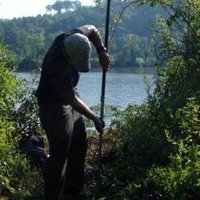Books by Juliet E Morrow
The organization of Early Paleoindian lithic technology in the confluence region of the Mississippi, Illinois, and Missouri Rivers, 1996
Lots of stuff you want to know about Early Paleoindians
This is the point recording form we'll be using for projectile points, knives, and other pointed ... more This is the point recording form we'll be using for projectile points, knives, and other pointed hafted tools from the Americas.
Papers by Juliet E Morrow

Science Advances, 2024
Ancient Native American ancestors (Clovis) have been interpreted as either specialized megafauna ... more Ancient Native American ancestors (Clovis) have been interpreted as either specialized megafauna hunters or generalist foragers. Supporting data are typically indirect (toolkits, associated fauna) or speculative (models, actualistic experiments). Here, we present stable isotope analyses of the only known Clovis individual, the 18-month-old Anzick child, to directly infer maternal protein diet. Using comparative fauna from this region and period, we find that mammoth was the largest contributor to Clovis diet, followed by elk and bison/camel, while the contribution of small mammals was negligible, broadly consistent with the Clovis zooarchaeological record. When compared with second-order consumers, the Anzick-1 maternal diet is closest to that of scimitar cat, a mammoth specialist. Our findings are consistent with the Clovis megafaunal specialist model, using sophisticated technology and high residential mobility to subsist on the highest ranked prey, an adaptation allowing them to rapidly expand across the Americas south of the Pleistocene ice sheets.
Current Research in the Pleistocene, 2009
Early Paleoindian fluted points found in west-central Illinois indicate long distance movement of... more Early Paleoindian fluted points found in west-central Illinois indicate long distance movement of toolstone from source(s) in southern Illinois.
Current Research in the Pleistocene, 2005
This article describes discarded Gainey style fluted points, manufacturing debris, and endscraper... more This article describes discarded Gainey style fluted points, manufacturing debris, and endscrapers from a Native American site near Montrose, Illinois. Long distance movement of lithic materials from west-central and southern Indiana and possibly west-central Illinois.
The 84th Annual Meeting of the Society for American Archaeology, 2019
MCJA. Midcontinental journal of archaeology, 1995

PaleoAmerica, Apr 3, 2019
Nine decades after the discovery of the Clovis type site, Blackwater Draw Locality No. 1, we are ... more Nine decades after the discovery of the Clovis type site, Blackwater Draw Locality No. 1, we are getting closer to solving the perplexing mystery of Clovis origins. Working together, geneticists and archeologists are closing in on the ancestral Northeast Asian and Beringian homelands. We can anticipate that future archaeology will fill in the details about the emergence of Clovis lithic technology, south of the ice sheets, from its Beringian precursors. Morphometric analysis of fluted points is increasingly used to address the origins of Clovis and the "mutation" of the Clovis form into other fluted point types. Since the early 2000s, cladistics, a technique borrowed from biology, has been employed in such analyses; the results are computer-constructed cladograms that purport to illustrate pseudo-genetic phylogenies of fluted points. Here, I critically examine the utility of cladistics for addressing the issue of Clovis origins and the stylistic or functional evolution of fluted points.
Seismological Research Letters, Mar 20, 2019
Lithic technology, Mar 1, 1997
Page 1. 70 Lithic Technology, volume 22, no. END SCRAPER MORPHOLOGY AND USE-LIFE: AN APPROACH FOR... more Page 1. 70 Lithic Technology, volume 22, no. END SCRAPER MORPHOLOGY AND USE-LIFE: AN APPROACH FOR STUDYING PALEOINDIAN LITHIC TECHNOLOGY AND MOBILITY Juliet E. Morrow ABSTRACT Kelly and ...
The 80th Annual Meeting of the Society for American Archaeology, 2015
Routledge eBooks, Oct 21, 2021

Southeastern Archaeology, Jun 1, 2011
Abstract Gradiometry survey at the Old Town Ridge (3CG41) site, a stockaded Middle Mississippian ... more Abstract Gradiometry survey at the Old Town Ridge (3CG41) site, a stockaded Middle Mississippian period town in the central Mississippi River Valley of Arkansas, demonstrates the efficacy of a broad-coverage, site-encompassing remote sensing methodology for initial interpretation of intrasite organization and complexity. Site access, time constraints, deep plow furrows, and cotton plant “stubble” associated with ongoing agriculture at the site defer the efficient use of a site-wide multisensor prospection methodology. However, a gradiometry survey identified multiple anomalies consistent with prehistoric structures, earthworks, earthquake liquefaction, and other interpreted features encompassed within the remains of a 7-ha, rectangular enclosure. Aerial photography, topography, and preliminary archaeological ground truthing provided additional information for analysis and interpretation.
Plains Anthropologist, Nov 1, 2002
RefDoc Bienvenue - Welcome. Refdoc est un service / is powered by. ...
Midcontinental Journal of Archaeology, Apr 7, 2014
Abstract Several researchers have suggested use of watercraft during the Early Paleoindian period... more Abstract Several researchers have suggested use of watercraft during the Early Paleoindian period 11,500 and 10,800 rcybp (13,400–12,700 cal B.P.), but none have brought empirical data to bear on this possibility. This paper addresses the potential for fluted point-making groups to have made and used boats circa 11,000 rcybp (13,000–12,800 cal B.P.). Fluted point data from a large region of the upper and central Mississippi River valley strongly suggest that the Mississippi River was a barrier to movement and that Early Paleoindians in the midcontinent did not routinely use watercraft.

American Antiquity, Apr 1, 1999
This paper examines geographic variation in fluted point morphology across North and South Americ... more This paper examines geographic variation in fluted point morphology across North and South America. Metric data on 449 North American points, 31 Central American points, and 61 South American points were entered into a database. Ratios calculated from these metric attributes are used to quantify aspects of point shape across the two continents. The results of this analysis indicate gradual, progressive changes in fluted point outline shape from the Great Plains of western North America into adjacent parts of North America as well as into Central and South America. The South American “Fishtail” form of fluted point is seen as the culmination of incremental changes in point shape that began well into North America. A geographically gradual decline in fluting frequency also is consistent with the stylistic evolution of the stemmed “Fishtail” points. Although few in number, the available radiocarbon dates do suggest that “Fishtail” fluted points in southern South America are younger than the earliest dates associated with Clovis points in western North America. All of these data converge on the conclusion that South American “Fishtail” points evolved from North American fluted points.











Uploads
Books by Juliet E Morrow
Papers by Juliet E Morrow
demographics and settlement technology, economics, social organization
political organization, religion, art and music, globalization and its impact on tribes, and forms of resistance among tribal peoples.